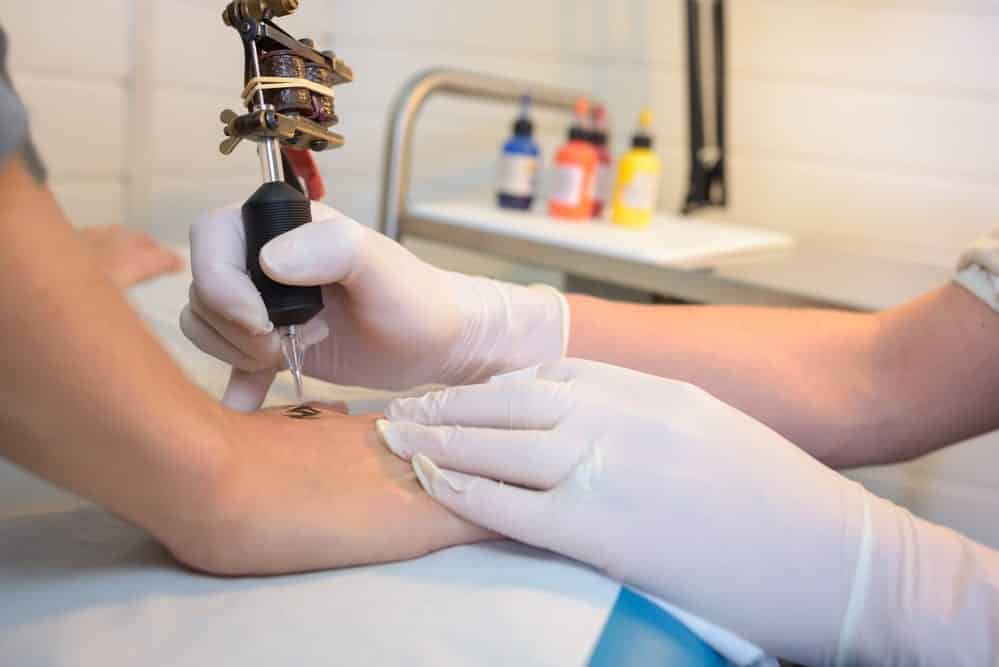Human skin provides invaluable information that can be used by health care professionals and researchers to monitor, prevent and treat health conditions. Devices in direct contact with the skin — called bioelectronics — can receive information about the state of the heart, the condition of muscles, and the hydration and impedance (electrical conductivity) of the skin.
Wearable bioelectronics have seen many advances over the past decade in the form of patches that are soft, stretchable and flexible. The most challenging hurdle remaining to traditional bioelectronics is motion artifacts. Weak adhesion or imperfect conformability of the bioelectronic leads to inconsistent interface between skin and the device. The inconsistency introduces motion artifacts, which can interrupt or corrupt readings and lead healthcare professionals to misinterpret or misdiagnose illnesses.
Uses and Benefits of Drawn-on-Skin Electronics
Drawn-on-skin (DoS) electronics is a new bioelectronics platform for on-demand, multifunctional and motion artifact–free sensing. It is created by liquid functional inks drawn directly into stencils on the skin using a modified ballpoint pen. The inks are based on an Ag-PEDOT:PSS and poly(3-hexylthiophene-2,5-diyl) nanofibrils (P3HT-NF). The interface between the DoS and the skin is ultra-conformal, robust, stretchable and immune to motion once applied.
DoS electronics has a wide range of uses. For example, a wireless DoS electrocardiogram (ECG) monitoring system can be used at home for daily monitoring or in a clinical setting.
DoS electronics can also be used as:
- Thin-film transistors
- Strain sensors
- Temperature sensors
- Heaters
- Hydration sensors
- Electrophysiological (EP) sensors
Experiments with DoS
A group of researchers at the University of Houston’s Department of Biomedical Engineering conducted a series of experiments using DoS electronics and two types of inks: a conductive Ag-PEDOT:PSS ink and P3HT-NF, an semiconducting ink.
After preparing the inks, the team constructed a stencil with a polyimide film and clear tape and adhered it to the target skin. Inks were drawn into the outlines of the stencils using a modified ballpoint pen with a 1mm diameter tip. Since the liquid forms a meniscus, the pen tip does not need to touch the skin to release the ink; the pen’s motion creates shear on the meniscus, causing the ink to spread. After three to five minutes, the stencil was removed, leaving a thin, dry film of ink on the skin.
The researchers then evaluated the ink-drawing characteristics, mechanical properties, skin compatibility and electrical performances of both the Ag-PEDOT:PSS and P3HT-NF inks.
Ink-Drawing Characteristics
Both the line width and resolution can be controlled by varying the tip diameter of the pen or using stencils. Drawing multiple times over the same location can create different thicknesses in the ink layer.
Robustness
In order to examine the ink’s robustness, both inks were drawn on synthetic skin made from polydimethylsiloxane (PDMS) and stretched, twisted and poked. Biaxial stretching created no cracks in the drawn structure, and neither twisting nor poking caused visible damage. The ink laid conformally on the skin.
Skin Compatibility
The team verified skin response to both the Ag-PEDOT:PSS and P3HT-NF inks by applying them to the backs of mice (after removing the mice’s fur). Subsequent skin samples showed no malignancies or inflammation of the epidermis or the dermis.
Electrical Performance
The DoS electrophysiological (EP) sensors function even under strain, with no observable changes in acquired signal.
DoS Electronics versus Existing Technologies
Researchers compared the DoS EP sensors, hospital-grade electrodes, and ultrathin serpentine mesh electrodes. The three types of bioelectronics were evaluated against various criteria: performance in the presence of sweat, durability over time, adhesion to skin and robustness against motion.
Sweat
The presence of sweat posed a particular challenge for hospital grade electrodes, interrupting the interface significantly. Both the ultrathin mesh and the DoS showed superior performance.
Adhesion
The skin adhesion of the sensors was examined through peeling and rubbing tests. The DoS could not be removed easily from the skin, in contrast to the easy removability of the other EP sensors. Additionally, the DoS EP sensors remained intact when rubbed vigorously; the other sensors were irreparably damaged. Any damage to the DoS sensors could be drawn over with additional ink, the other types of sensors would have to be entirely replaced.
Durability
All three types of EP sensors were tested over the course of a seven-hour ECG. The DoS sensors performed consistently over time, unlike the other sensors, the sensitivity and accuracy of which decreased.
Robustness Against Motion Artifacts
The research team conducted two experiments on humans: local skin deformation while recording ECG signals and vibration of the arm while recording resting electromyography (EMG) signals. A human subject was recorded with regular intervals of stretching, compressing and releasing the skin at the site of one of each type of sensor. During these motions — which are extreme compared to normal day-to-day motions — the DoS EP sensors showed no abnormal deviations from the ECG wave form. The hospital-grade gel electrodes and the mesh electrodes showed signal fluctuations and wave deformations. In the EMG vibration experiment, the DoS EP sensors and hospital-grade gel electrodes showed no obvious susceptibility to the vibration, whereas the mesh electrodes were substantially affected.
Accelerated Skin Wound Healing
The application of pulsed electrical stimulation for skin wound healing has been shown to accelerate recovery. DoS electrodes can be customized to any wound shape or size, a clear advantage over traditional wound healing with electrodes. The research team experimented using a mouse model, drawing electrodes on the top half of a surgically created wound. The part of the wound treated with the DoS electronics both scabbed over and healed more quickly than the non-stimulated half of the wound.
Changing the Bioelectronics Field
DoS electronics has major advantages over existing EP-sensing technologies. Point-of-care treatment and portability makes DoS particularly suited for low-resource areas, such as the wilderness, developing nations or the battlefield. Resistance to sweat, motion artifacts and physical damage makes DoS electronics more durable and sustainable. Finally, the simplicity of the drawing process provides easy access to creating DoS electronics on demand, making it a robust, versatile healthcare and research tool.
Since 1995, QPS has provided discovery, preclinical, and clinical drug development services. An award-winning leader focused on bioanalytics and clinical trials, QPS is known for proven quality standards, technical expertise, a flexible approach to research, client satisfaction and turnkey laboratories and facilities. For more information, visit www.qps.com or email info@qps.com.








